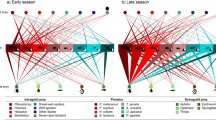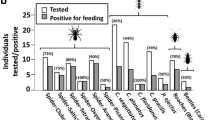Abstract
Generalist predators have the capacity to regulate herbivore populations through a variety of mechanisms, but food webs are complex and defining the strength of trophic linkages can be difficult. Molecular gut-content analysis has revolutionized our understanding of these systems. Utilizing this technology, we examined the structure of a soybean food web, identified the potential for adult and immature Orius insidiosus (Hemiptera: Anthocoridae) to suppress Aphis glycines (Hemiptera: Aphididae), and tested the hypotheses that foraging behaviour would vary between life stages, but that both adults and immatures would exert significant predation pressure upon this invasive pest. We also identified the strength of trophic pathways with two additional food items: an alternative prey item, Neohydatothrips variabilis (Thysanoptera: Thripidae), and an intraguild predator, Harmonia axyridis (Coleoptera: Coccinellidae). A. glycines constituted a greater proportion of the diet of immature O. insidiosus, but N. variabilis DNA was found in greater frequency in adults. However, both life stages were important early-season predators of this invasive pest, a phenomenon predicted as having the greatest impact on herbivore population dynamics and establishment success. No adult O. insidiosus screened positive for H. axyridis DNA, but a low proportion (2.5%) of immature individuals contained DNA of this intraguild predator, thus indicating the existence of this trophic pathway, albeit a relatively minor one in the context of biological control. Interestingly, approximately two-thirds of predators contained no detectable prey and fewer than 3% contained more than one prey item, suggesting the possibility for food limitation in the field. This research implicates O. insidiosus as a valuable natural enemy for the suppression of early-season A. glycines populations.



Similar content being viewed by others
References
Agustí N, Shayler SP, Harwood JD, Vaughan IP, Sunderland KD, Symondson WOC (2003) Collembola as alternative prey sustaining spiders in arable ecosystems: prey detection within predators using molecular markers. Mol Ecol 12:3467–3475. doi:10.1046/j.1365-294X.2003.02014.x
Aljanabi SM, Martinez I (1997) Universal and rapid salt-extraction of high quality genomic DNA for PCR-based techniques. Nucleic Acids Res 25:4692–4693. doi:10.1093/nar/25.22.4692
Anderson JF (1974) Responses to starvation in the spiders Lycosa lenta Hentz and Filistata hibernalis (Hentz). Ecology 55:576–585. doi:10.2307/1935148
Bilde T, Toft S (1998) Quantifying food limitation of arthropod predators in the field. Oecologia 115:54–58. doi:10.1007/s004420050490
Bilde T, Toft S (2000) Evaluation of prey for the spider Dicymbium brevisetosum Locket (Araneae: Linyphiidae) in single-species and mixed-species diets. Ekologia (Bratisl) 19:9–18
Bilde T, Axelsen JA, Toft S (2000) The value of Collembola from agricultural soils as food for a generalist predator. J Appl Ecol 37:673–683. doi:10.1046/j.1365-2664.2000.00527.x
Bonsall MB, Hassell MP (2007) Predator-prey interactions. In: May RM, McLean AR (eds) Theoretical ecology: principals and applications. Oxford University Press, Oxford, United Kingdom, pp 46–61
Brosius TR, Higley LG, Hunt TE (2007) Population dynamics of soybean aphid and biotic mortality at the edge of its range. J Econ Entomol 100:1268–1275. doi:10.1603/0022-0493(2007)100[1268:PDOSAA]2.0.CO;2
Butler CD, O’Neil RJ (2007a) Life history characteristics of Orius insidiosus (Say) fed Aphis glycines Matsumura. Biol Control 40:333–338. doi:10.1016/j.biocontrol.2006.12.006
Butler CD, O’Neil RJ (2007b) Life history characteristics of Orius insidiosus (Say) fed diets of soybean aphid, Aphis glycines Matsumura and soybean thrips, Neohydatothrips variabilis (Beach). Biol Control 40:339–346. doi:10.1016/j.biocontrol.2006.12.005
Chang GC, Kareiva P (1999) The case for indigenous generalists in biological control. In: Hawkins BA, Cornell HV (eds) Theoretical approaches to biological control. Cambridge University Press, Cambridge, United Kingdom, pp 103–105
Chiverton PA (1986) Predator density manipulation and its effects on populations of Rhopalosiphum padi (Hom.: Aphididae) in spring barley. Ann Appl Biol 109:49–60. doi:10.1111/j.1744-7348.1986.tb03183.x
Colfer RG, Rosenheim JA (2001) Predation on immature parasitoids and its impact on aphid suppression. Oecologia 126:292–304. doi:10.1007/s004420000510
Costamagna AC, Landis DA (2006) Predators exert top–down control of soybean aphid across a gradient of agricultural systems. Ecol Appl 16:1619–1628. doi:10.1890/1051-0761(2006)016[1619:PETCOS]2.0.CO;2
Costamagna AC, Landis DA, Brewer MJ (2008) The role of natural enemy guilds in Aphis glycines suppression. Biol Control 45:368–379. doi:10.1016/j.biocontrol.2008.01.018
Desneux N, O’Neil RJ, Yoo HJS (2006) Suppression of population growth on the soybean aphid, Aphis glycines Matsumura, by predators: the identification of a key predator and the effects of prey dispersion, predator abundance, and temperature. Environ Entomol 35:1342–1349. doi:10.1603/0046-225X(2006)35[1342:SOPGOT]2.0.CO;2
Donaldson JR, Myers SW, Gratton C (2007) Density-dependent responses of soybean aphid (Aphis glycines Matsumura) populations to generalist predators in mid to late season soybean fields. Biol Control 43:111–118. doi:10.1016/j.biocontrol.2007.06.004
Fawki S, Toft S (2005) Food preferences and the value of animal food for the carabid beetle Amara similata (Gyll.) (Col., Carabidae). J Appl Entomol 129:551–556. doi:10.1111/j.1439-0418.2005.00992.x
Fox TB, Landis DA, Cardoso FF, Difonzo CD (2004) Predators suppress Aphis glycines Matsumura population growth in soybean. Environ Entomol 33:608–618
Fox TB, Landis DA, Cardoso FF, Difonzo CD (2005) Impact of predation on establishment of the soybean aphid, Aphis glycines in soybean, Glycine max. Biocontrol 50:545–563. doi:10.1007/s10526-004-6592-1
Greenstone MH (1989) Spider behaviour optimises dietary essential amino acid composition. Nature 282:501–503. doi:10.1038/282501a0
Greenstone MH (2006) Molecular methods for assessing insect parasitism. Bull Entomol Res 96:1–14. doi:10.1079/BER2005402
Hagler JR, Naranjo SE (2005) Use of a gut content ELISA to detect whitefly predator feeding activity after field exposure to different insecticide treatments. Biocontrol Sci Technol 15:321–339. doi:10.1080/09583150500086474
Harper GL, King RA, Dodd CS, Harwood JD, Glen DM, Bruford MW et al (2005) Rapid screening of predators for multiple prey DNA targets. Mol Ecol 14:819–828. doi:10.1111/j.1365-294X.2005.02442.x
Harwood JD, Sunderland KD, Symondson WOC (2004) Prey selection by linyphiid spiders: molecular tracking the effects of alternative prey on rates of aphid consumption in the field. Mol Ecol 13:3549–3560. doi:10.1111/j.1365-294X.2004.02331.x
Harwood JD, Desneux N, Yoo HJS, Rowley DL, Greenstone MH, Obrycki JJ et al (2007) Tracking the role of alternative prey in soybean aphid predation by Orius insidiosus: a molecular approach. Mol Ecol 16:4390–4400. doi:10.1111/j.1365-294X.2007.03482.x
Heimpel GE, Ragsdale DW, Venette R, Hopper KR, O’Neil RJ, Rutledge CE et al (2004) Prospects for importation biological control of the soybean aphid: anticipating potential costs and benefits. Ann Entomol Soc Am 97:249–258. doi:10.1603/0013-8746(2004)097[0249:PFIBCO]2.0.CO;2
Juen A, Traugott M (2007) Revealing species-specific trophic links in soil food webs: molecular identification of scarab predators. Mol Ecol 16:1545–1557. doi:10.1111/j.1365-294X.2007.03238.x
Kaiser ME, Noma T, Brewer MJ, Pike KS, Vockeroth JR, Gaimari SD (2007) Hymenopteran parasitoids and dipteran predators found using soybean aphid after its Midwestern United States invasion. Ann Entomol Soc Am 100:196–205. doi:10.1603/0013-8746(2007)100[196:HPADPF]2.0.CO;2
Koss AM, Snyder WE (2005) Alternative prey disrupt biocontrol by a guild of generalist predators. Biol Control 32:243–251. doi:10.1016/j.biocontrol.2004.10.002
Landis DA, Van der Werf W (1997) Early-season predation impacts the establishment of aphids and spread of beet yellows virus in sugar beet. Entomophaga 42:499–516. doi:10.1007/BF02769810
Liu J, Wu K, Hopper KR, Zhao K (2004) Population dynamics of Aphis glycines (Homoptera: Aphididae) and its natural enemies in soybean in Northern China. Ann Entomol Soc Am 97:235–239. doi:10.1603/0013-8746(2004)097[0235:PDOAGH]2.0.CO;2
Lundgren JG, Fergen JK, Riedell WE (2008) The influence of plant anatomy on oviposition and reproductive success on the omnivorous bug Orius insidiosus. Anim Behav 75:1495–1502. doi:10.1016/j.anbehav.2007.09.029
Madsen M, Terkildsen S, Toft S (2004) Microcosm studies on control of aphids by generalist arthropod predators: effects of alternative prey. Biocontrol 49:483–504. doi:10.1023/B:BICO.0000036442.70171.66
Marcussen BM, Axelsen JA, Toft S (1999) The value of two Collembola species as food for a linyphiid spider. Entomol Exp Appl 92:29–36. doi:10.1023/A:1003787208256
Mayntz D, Raubenheimer D, Salomon M, Toft S, Simpson SJ (2005) Nutrient-specific foraging in invertebrate predators. Science 307:111–113. doi:10.1126/science.1105493
Miao J, Wu K, Hopper KR, Li G (2007) Population dynamics of Aphis glycines (Homoptera: Aphididae) and impact of natural enemies in Northern China. Environ Entomol 36:840–848. doi:10.1603/0046-225X(2007)36[840:PDOAGH]2.0.CO;2
Mignault MP, Roy M, Brodeur J (2006) Soybean aphid predators in Quebec and the suitability of Aphis glycines as prey for three Coccinellidae. Biocontrol 51:89–106. doi:10.1007/s10526-005-1517-1
Murdoch WW, Chesson J, Chesson PL (1985) Biological control in theory and practice. Am Nat 125:344–366. doi:10.1086/284347
Nielsen C, Hajek AE (2005) Control of invasive soybean aphid, Aphis glycines (Hemiptera: Aphididae), populations by existing natural enemies in New York State, with emphasis on entomopathogenic fungi. Environ Entomol 34:1036–1047. doi:10.1603/0046-225X(2005)034[1036:COISAA]2.0.CO;2
Prasad RP, Snyder WE (2006) Polyphagy complicates conservation biological control that targets generalist predators. J Appl Ecol 43:343–352. doi:10.1111/j.1365-2664.2006.01129.x
Ragsdale DW, Voegtlin DJ, O’Neil RJ (2004) Soybean aphid biology in North America. Ann Entomol Soc Am 97:204–208. doi:10.1603/0013-8746(2004)097[0204:SABINA]2.0.CO;2
Ragsdale DW, McCornack BP, Venette RC, Potter BD, Macrae IV, Hodgson EW et al (2007) Economic threshold for soybean aphid (Hemiptera: Aphididae). J Econ Entomol 100:1258–1267. doi:10.1603/0022-0493(2007)100[1258:ETFSAH]2.0.CO;2
Richardson ML, Lagos DM (2007) Effects of a juvenile hormone analogue, pyriproxyfen, on the apterous form of soybean aphid (Aphis glycines). J Appl Entomol 131:297–302. doi:10.1111/j.1439-0418.2007.01163.x
Rodas S, O’Neil RJ (2006) Survey of Indiana soybean producers following the introduction of a new pest, the soybean aphid. Am Entomol 52:146–149
Rosenheim JA (2005) Intraguild predation of Orius tristicolor by Geocoris spp. And the paradox of irruptive spider mite dynamics in California cotton. Biol Control 32:172–179. doi:10.1016/j.biocontrol.2004.09.007
Rutledge CE, O’Neil RJ (2005) Orius insidiosus (Say) as a predator of the soybean aphid, Aphis glycines Matsumura. Biol Control 33:56–64. doi:10.1016/j.biocontrol.2005.01.001
Rutledge CE, O’Neil RJ, Fox TB, Landis DA (2004) Soybean aphid predators and their use in Integrated Pest Management. Ann Entomol Soc Am 97:240–248. doi:10.1603/0013-8746(2004)097[0240:SAPATU]2.0.CO;2
Schmidt NP, O’Neal ME, Singer JW (2007) Alfalfa living mulch advances biological control of soybean aphid. Environ Entomol 36:416–424. doi:10.1603/0046-225X(2007)36[416:ALMABC]2.0.CO;2
Settle WH, Ariawan H, Astuti ET, Cahyana W, Hakim AL, Hindayana D et al (1996) Managing tropical rice pests through conservation of generalist natural enemies and alternative prey. Ecology 77:1975–1988. doi:10.2307/2265694
Sheppard SK, Harwood JD (2005) Advances in molecular ecology: tracking trophic links through predator-prey food webs. Funct Ecol 19:751–762. doi:10.1111/j.1365-2435.2005.01041.x
Snyder WE, Wise DH (2001) Contrasting trophic cascades generated by a community of generalist predators. Ecology 82:1571–1583
Snyder WE, Snyder GB, Finke DL, Straub CS (2006) Predator biodiversity strengthens herbivore suppression. Ecol Lett 9:789–796. doi:10.1111/j.1461-0248.2006.00922.x
Snyder GB, Finke DL, Snyder WE (2008) Predator biodiversity strengthens aphid suppression across single- and multiple-species prey communities. Biol Control 44:52–60
Sunderland KD, Crook NE, Stacey DL, Fuller BJ (1987) A study of feeding by polyphagous predators on cereal aphids using ELISA and gut dissection. J Appl Ecol 24:907–933. doi:10.2307/2403989
Sunderland KD, Axelsen JA, Dromph K, Freier B, Hemptinne JL, Holst NH et al (1997) Pest control by a community of natural enemies. Acta Jutl 72:271–326
Symondson WOC (2002) Molecular identification of prey in predator diets. Mol Ecol 11:627–641. doi:10.1046/j.1365-294X.2002.01471.x
Symondson WOC, Cesarini S, Dodd PW, Harper GL, Bruford MW, Glen DM et al (2006) Biodiversity vs biocontrol: positive and negative effects of alternative prey on control of slugs by carabid beetles. Bull Entomol Res 96:637–645. doi:10.1017/BER2006467
Toft S (2005) The quality of aphids as food for generalist predators: implications for natural control of aphids. Eur J Entomol 102:371–384
Traugott M (2003) The prey spectrum of larval and adult Cantharis species in arable land: an electrophoretic approach. Pedobiologia (Jena) 47:161–169. doi:10.1078/0031-4056-00179
Venette RC, Ragsdale DW (2004) Assessing the invasion by soybean aphid (Homoptera: Aphididae): where will it end? Ann Entomol Soc Am 97:219–226. doi:10.1603/0013-8746(2004)097[0219:ATIBSA]2.0.CO;2
Zhang GF, Lü ZC, Wan FH (2007) Detection of Bemisia tabaci remains in predator guts using a sequence-characterized amplified region marker. Entomol Exp Appl 123:81–90. doi:10.1111/j.1570-7458.2007.00528.x
Acknowledgements
J.D.H., H.J.S.Y. and M.H.G. are indebted to their co-author, Bob O’Neil, who passed away prior to preparation of this manuscript, for his support, encouragement and insights into this research initiative. All experiments comply with the current laws and regulations of the United States of America. J.D.H. is supported by the University of Kentucky Agricultural Experiment Station State Project KY008043. This work was supported, in part, by a grant from USDA/CSREES NRI (2003–03334) as well as through support of the Indiana Soybean Alliance, and the North Central Soybean Research Program. This paper is publication number 08-08-053 of the University of Kentucky Agricultural Experiment Station.
Author information
Authors and Affiliations
Corresponding author
Rights and permissions
About this article
Cite this article
Harwood, J.D., Yoo, H.J.S., Greenstone, M.H. et al. Differential impact of adults and nymphs of a generalist predator on an exotic invasive pest demonstrated by molecular gut-content analysis. Biol Invasions 11, 895–903 (2009). https://doi.org/10.1007/s10530-008-9302-6
Received:
Accepted:
Published:
Issue Date:
DOI: https://doi.org/10.1007/s10530-008-9302-6




